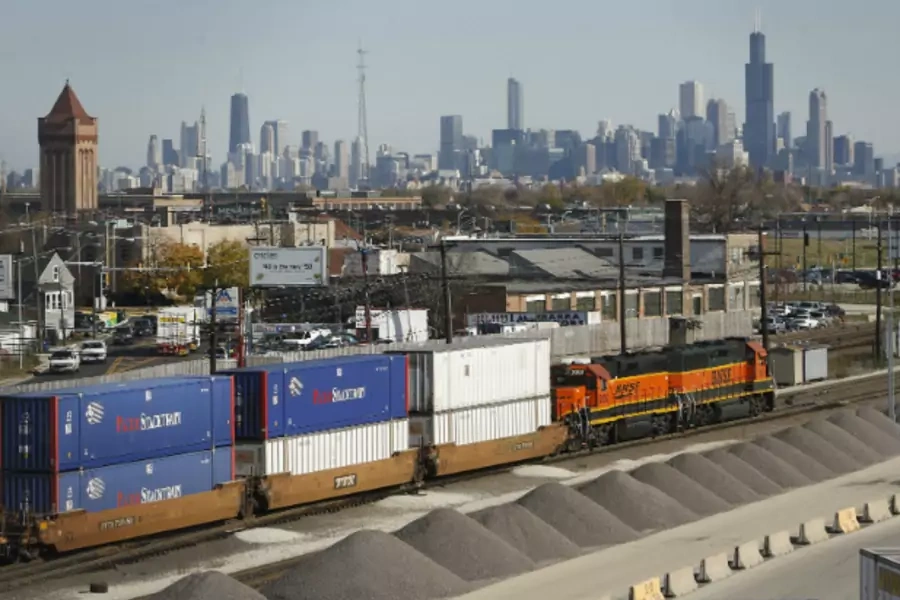Morning Brief: Chicago Combats Rail Congestion

More on:
The New York Times discusses the importance of Chicago to the U.S. rail network and an infrastructure investment program to reduce delays and chokepoints. The effects will be felt far beyond Chicago; a quarter of all U.S. rail traffic flows through the Windy City. The Chicago Region Environmental and Transportation Efficiency Program—CREATE for short—pulls funding from private sources, state bonds and federal funds for needed infrastructure construction. But CREATE’s future projects may be stalled by Congress’ lack of progress on a national transportation investment program. The staff director of a Chicago consumer group opined, “it seems like as much gridlock as we’ve got with our trains, it’s even worse in Washington, DC.”
Lawmakers continue to debate the costs and benefits of investment in the U.S. rail network. This CFR Backgrounder by contributor Elizabeth Dovell, summarizes the historical development of freight and passenger rail as well as policy concerns and options facing lawmakers.
Nevada Legalizes Testing of Google Self-Driving Cars
Google notched a win as Nevada became the first state to legalize the testing of driverless cars on its roads (CNET). Google continues to develop autonomous driving systems, which the company claims can “help prevent traffic accidents, free up people's time, and reduce carbon emissions by fundamentally changing car use." If widely adopted, Google’s system could also increase highway capacity by allowing vehicles to safely travel at high speeds with little distance between them. Google is also trying to involve automakers and the insurance industry.
Infrastructure. Read more on how upgrading the nation’s aging network of roads, bridges, airports, railways, and water systems is essential to maintaining U.S. competitiveness.
Innovation
Does the Software Patent System Stymie Growth?
Columnist Vivek Wadhwa believes that the current system of software patents stymies innovation (WashPost). He argues that the granting of overly broad patents causes large companies to spend billions in litigation and defensive patent acquisition, while innovative startups are bullied out of markets. Reforming the process requires limiting software patents to their method of action, rather than the problems they solve.
Should the United States adopt a "patent box" tax incentive as several European countries have done in recent years in order to spur innovation? This Policy Initiative Spotlight examines the issue alongside a more conventional policy, the research, and development tax credit.
Innovation. Read more on how the U.S. capacity to innovate could play a chief role in economic growth.
Education and Human Capital
Rates of Return for College Vary Widely
While college-educated workers have a higher median income, the Wall Street Journal’s discussion of an analysis by PayScale argues the rate of return differs widely. While the median student does enjoy a 4.4 percent annual return, over 100 colleges delivered negative returns, while the best schools had over 11 percent. Higher average returns are earned by students who achieve high grades, attend schools with strong brands, earn financial aid, and/or pursue more lucrative majors such as engineering, computer science, economics, and the natural sciences.
Education and human capital. Read more from experts discussing ways to improve U.S. education and immigration policies.
Corporate Regulation and Taxation
Facebook Could Avoid up to $14 Billion in Taxes
Facebook’s impending initial public offering could net the leading social network a U.S. tax deduction of up to $14 billion (The Telegraph). Current IRS rules allow firms to deduct the value of options exercised by employees; often these deductions are far larger than expenses claimed by the companies. Senator Carl Levin (D-MI) called attention to this aspect of the tax code earlier this year: “When it comes time to pay taxes, to pay Uncle Sam, the loophole in the tax code allows the company to take a tax deduction for a far larger expense than they show on their books.”
The current U.S. corporate tax code gives the United States a competitive disadvantage by combining the highest statutory corporate tax rate in the world—35 percent for federal taxes alone—with a complex system of tax subsidies and loopholes. This CFR Backgrounder discusses the effect of current policy, and proposals for U.S. Corporate Tax Reform.
Corporate regulation and taxation. Read more from top economists and business experts on solutions for addressing corporate tax reform.
Debt and Deficits
Economists Debate Effects of Capital Gains Taxes
The Economist discusses a growing debate among some economists about the wisdom of capital gains taxes. For decades, economic models predicted the optimal tax rate on capital gains was zero; spurring investment would improve incomes for all. But new research argues that capital gains taxes can help decrease inequity and political instability with relatively little influence on workers saving for retirement and wealthy families with multi-generational inheritance. Economists that think higher capital gains taxes make sense globally, but usually acknowledge that any individual nation that enacted higher taxes would be at a competitive disadvantage because capital is mobile.
Debt and deficits. Read more from experts on the challenges in reducing U.S. debt.
The Morning Brief is compiled by Renewing America contributor Steven J. Markovich.
More on:
 Online Store
Online Store